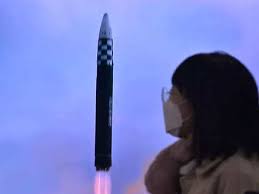
North Korea fires long-range missile after warning over military drills

North Korea has launched a long-range ballistic missile into the sea off Japan’s west coast after warning of a strong response to upcoming military drills by South Korea and the United States.
Japanese authorities said the missile plunged into waters inside Japan’s Exclusive Economic Zone (EEZ) on Saturday more than an hour after it was launched, suggesting the weapon was one of Pyongyang’s largest missiles.
Japanese Prime Minister Fumio Kisihda said the missile appeared to have been an ICBM-class, i.e. Inter Continental Ballistic Missile. He said the launch was a threat to the international community and strongly condemned by Japan.
Japanese defence minister Yasukazu Hamada said the missile appeared to have a range of more than 14,000 kilometres, which was sufficient to reach the US mainland.
In South Korea, which denounced the launch as a “clear breach of UN Security Council resolutions“, the chiefs of staff said the missile had flown about 900km before splashing into the sea.
North Korea’s first missile firing since January 01, 2023 came after Pyongyang threatened on Friday an “unprecedentedly persistent, strong” response as South Korea and the United States gear up for annual military exercises as part of efforts to fend off the North’s growing nuclear and missile threats.
North Korean state media reported that Saturday’s launch was designed to confirm the weapon’s reliability. State news agency KCNA said the missile flew 989 kilometres to an altitude of 5,768km for 4,015 seconds (67 minutes).
Following Saturday’s launch, South Korea’s National Security Council convened a meeting and agreed to increase cooperation on security with Washington and Japan.
The US Indo-Pacific Command said in a statement that US commitments to the defence of Japan and South Korea “remain ironclad”.
Seeking to present a united front with South Korea and Japan, US Secretary of State Antony Blinken described the launch as a “provocative” act in remarks alongside his counterparts from the two countries on Saturday.
The White House said it was taking necessary measures to protect the US homeland and regional allies, but that the launch did not pose any immediate threat.
The G7 foreign ministers condemned the launch and called for a unified response from the international community.
Nuclear-armed North Korea fired an unprecedented number of missiles last year, including ICBMs that are capable of striking anywhere in the United States while resuming preparations for its first nuclear test since 2017.
Saturday’s missile was launched from the Sunan area near Pyongyang, South Korea’s military said. Sunan is the site of the Pyongyang International Airport, where North Korea has conducted most of its recent ICBM tests.
North Korea’s ballistic missile and nuclear weapons programmes are banned under UN Security Council resolutions, but Pyongyang says its weapons development is necessary to counter “hostile policies” by Washington and its allies.
Allied nuclear drills, called the Deterrence Strategy Committee Tabletop Exercise, are scheduled for Wednesday at the Pentagon and will involve senior defence policymakers from both sides, according to Seoul’s defence ministry.
The two countries are also planning a range of expanded field exercises, including live fire drills, in the coming weeks and months. Some 28,500 US troops are stationed in South Korea as a legacy of the Korean War.
“With a focus on North Korea’s nuclear threats, both sides will have in-depth discussions on various measures to strengthen US extended deterrence, including information sharing and consultation procedures,” South Korea’s defence ministry said in a statement.
Heo Tae-keun, South Korea’s deputy minister of national defence policy, also told legislators on Friday that the two countries would hold joint field exercises in mid-March that would be bigger than those held in the past few years. The exercises are expected to include live-fire drills.








